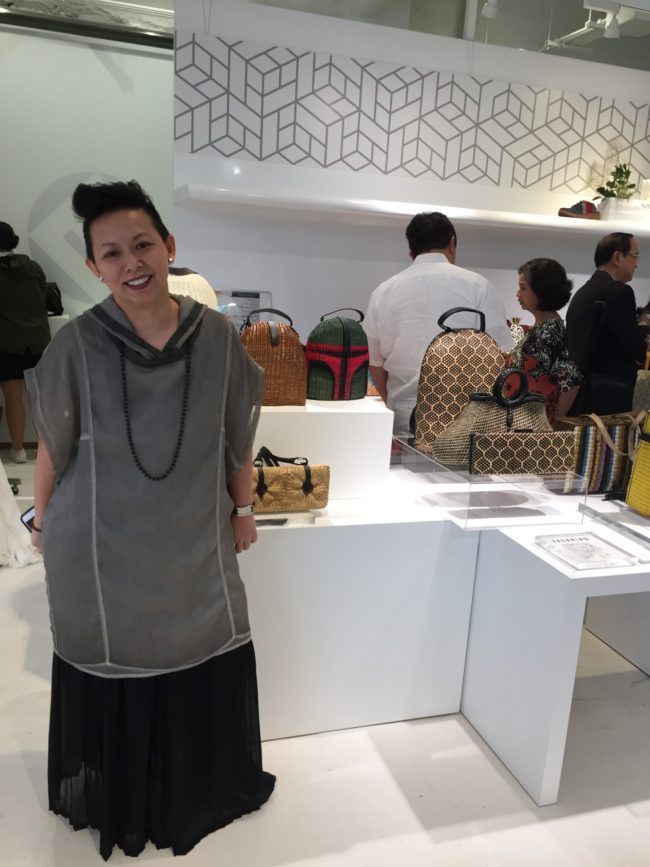Exclusively by Hand: Philippine Design

As I was walking in the rain in the Marunouchi area of Tokyo on Monday, I saw a shop that was a hive of activity and being set up with beautiful items. The sign in the window said, “Exclusively by Hand: Philippine Design Exhibition.” It did not look touristy; it looked luxe.
Guess what I saw on the table directly in front of the entrance: business cards with my name! Well, almost my name. The brand name was Zacarias 1925; mine has an H after the C. I, of course, pointed out the spelling difference and this led to a discussion about how the name seems to be everywhere but yet only in small numbers. It turns out that Rita Nazereno, the creative director, had a grandfather with the last name of Zacarias who was a sculptor. Her grandmother founded the S.C. Vizcarra workshop and brand in 1925, hence the number in the brand name.
The lookbook for the show says, “The selection of bags and objects references contemporary art, architecture, cinema and design, and employs traditional Filipino hand-weaving techniques.” As you can see in the photo, the bags are striking with their interesting shapes, graphic designs, and colours. The woven materials remind me of the bamboo vases and other souvenir items sold throughout Japan as souvenirs but these are much more refined and stylish. If I recall correctly, Nazereno mentioned that the small, rectangular clutch bag behind her was made from pineapple fibres.
Nazareno introduced me to Efril Caranglan, the representative from John Herrera. I had seen the Issey Miyake show at the National Arts Center in the morning, and this dress reminded me of some of the designs I had seen there. (Nazareno coincidentally had also been there, but it took a few hours for us to meet here instead.) The lookbook has a detailed explanation for this dress.
The Golden Butterfly is based on the Philippine is based on the Philippine national dress, the ‘terno’, traditionally associated with the demure and delicate Filipina. The designer transforms the garment into a suit of armor for the modern Filipina by retaining its basic silhouette and distinct butterfly sleeves. The pieces are constructed to appear as if made up of separate pieces that recall the armor’s breastplate, arm guards and straps. A deft use of golden neoprene inserts and zippers highlights the battle-gear references.
Don’t you think that the dress in the middle has a Forties influence? Or perhaps an Eighties, Thierry Mugler vibe?
Several of the handbags by Aranaz could also have easily been in the Miyake show, which often used unusual materials in familiar ways or familiar materials in unusual ways and often used traditional methods to do so. Both Aranaz and Zacarias 1925 use traditional Filipino weaving and craft techniques.
If you look carefully, you can see necklaces by Adante Leyesa on the shelves in the background and the jeweled bag and the pom-pom bag on the possibly rattan stand in the foreground is also one of his designs.
I think the sandals and bags on the bottom shelf of that same photo are by Maco Custodio. A simple design can be one of the most challenging to make.
How can you not love somebody whose name is Happy? Yes, Happy Andrada lives up to her name. She was a pleasure to talk to and made time for me even though she was wrapping up one outfit to move to another venue. Her brand Happy V Andrada used pineapple and abaca fibres as well as embroidery and embellishments to reflect Filipino mestizo heritage. I loved the colours of this dress. I know that the buttons and embroidery of the front are a tribute to the traditional Filipino dress shirt called a barong but I think without the buttons the dress would be a modern version of a flapper’s dress from the Twenties.
This beautiful chair was made by designer Ito Kish, who also curated this show. It was made of balusters also known as spindles. I never knew there was a Filipino connection with balusters, but his pamphlet says there is.
[The Baluster] collections is inspired by the near omnipresence of balusters in vintage Philippine design. From its humble beginnings as seating and storage, to ventanillas that allow air to flow in and out of the homes Filipinos grew up in, to decorative details in staircases — the baluster is an icon in Philippine lifestyle. It is now given a new twist to be appreciated by a new generation.
Check out his website for more designs. They are beautiful as well as sweeping up awards by the handful.
Behind the chair in the background, you can see the grey-and-white chinaware of CSM.
My apologies to Calli and Joanique for not getting photos of their evening bags or jewellery. Midway I thought I might have been interrupting everybody as they were setting up the show and thought that I had better leave. Everybody seemed hard at work. Otherwise I gladly would have spent longer chatting with everybody!
The current show is at Good Design Marunouchi until June 30. Languages: English, Japanese, and I assume Tagalog. Everybody is friendly and glad to answer any questions you might have.





You bring the most amazing stuff into my world.
LOL! Glad to oblige. Tell your friends, please! You have my permission to spread the word and share. 😉